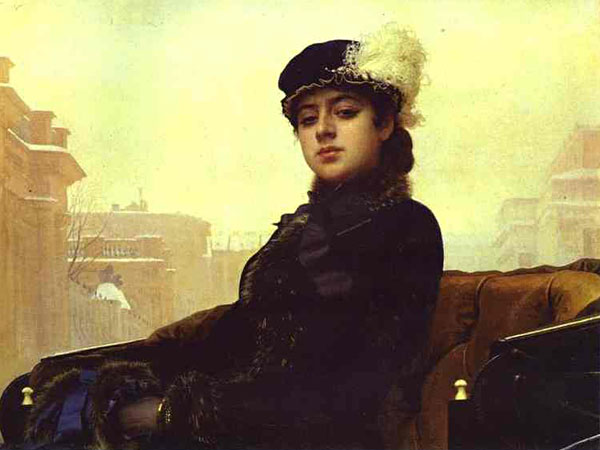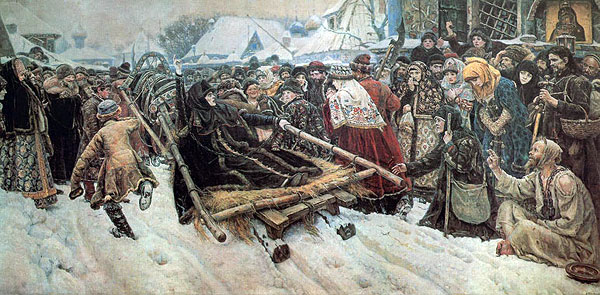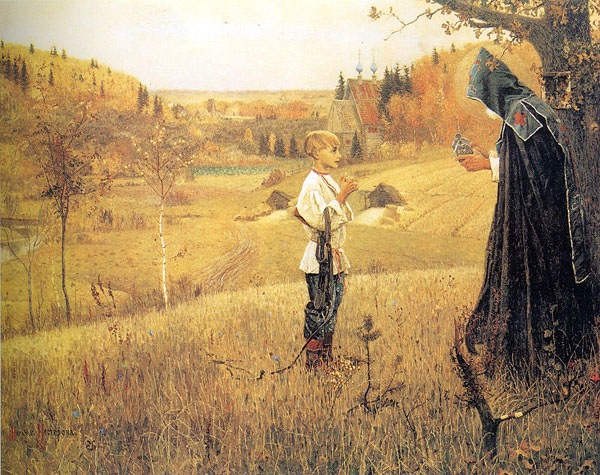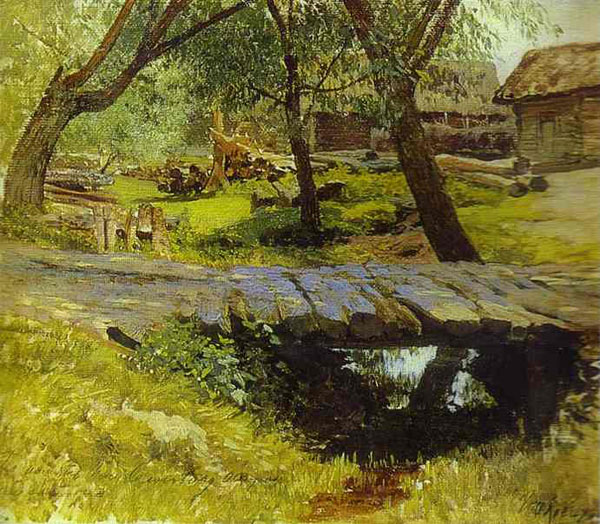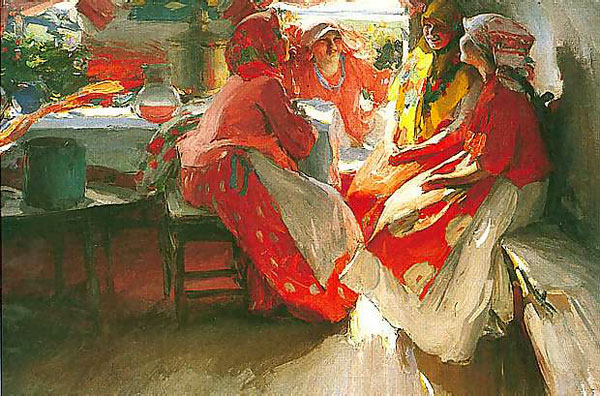Dear Artist,
Right from the very beginning, Pavel Tretyakov let everyone know that he was collecting not for himself but for the state. The inheritor of moderately successful importing, textile and banking businesses, Pavel, at age 24, started out by buying himself a dozen Dutch Masters. Not the cigars. But it was with Russian painters that he soon became associated. Sometimes he would take advice from the experts, but more often than not he just bought what he liked. Sometimes, to be contrary, he bought things he didn’t like. Because it was known that he would eventually give his collection to the state, he was offered special favours, previews, dealer tip-offs, and entrees into artists’ studios. Sometimes he bought whole collections or periods of artists. He commissioned portraits of the great and famous. Because he was buying for a greater cause he was able to augment his own money with that of the city of Moscow. When he died there were 1635 works of art that could be viewed by the public in his considerably expanded home.
Pavel Tretyakov (1832-1898) was to be the founder of an empire. Today the Tretyakov Gallery has more than 130,000 exhibits, several locations, satellite museums, historic studios and related foundations. Pavel was a giving kind of guy — endowing a variety of charities including a school for deaf-mutes and the setting up of legacies for impoverished painters. Successful artists even entrusted their money to his management. Tretyakov was one of the great art benefactors. He takes his place with Andrew Carnegie, Andrew Mellon, Chester Dale and others who amassed great collections that were to become public. For the benefit of all, these guys simply bought their own immortality.
The Tretyakov Gallery has something for everyone. There are enough Russian Orthodox icons to sink the Battleship Potemkin. The Modern Annex currently has a brilliant collection of paintings, sculpture, ceramics, posters and tapestries celebrating the “Great Patriotic War.” But it’s the period of Tretyakov’s personal collecting after 1860 that blows me away. There’s an education at every turn — what they did right — and the stuff that gave them trouble. There’s nothing like the thrill of all-time favourites seen for the first time in the flesh.
Best regards,
Robert
PS: “Connect your life with the eternal.” (Andrew Mellon) “What we do for ourselves dies with us; what we have done for others and for the world remains and is immortal.” (Albert Pike)
Esoterica: In the second half of the 19th century a poetic perception of the world was being replaced by a critical interpretation of it. There was a desire to transform society. Also, democratic, “genre” paintings began to counter the art of the salons and the Academy. It was a time of high moral ideals. There was a complexity and a diversity to man’s spiritual world. Artists were concerned with duty to society, the search for meaning in life, human suffering, harmony and love. Where are they now?
Tretyakov Collection Paintings
Wedding Procession in Moscow :: Illustrational material that tells a story — full of anecdote. Note red-coated attendants running beside red carriage, doll-like girl on right rejected. Nice pattern and jumpy red helps linear movement across the picture plane.
The Whirlwind :: Careful rendering in faces and the rest a wild rush of colour, brushed and scraped. The viewer’s eye makes the virtually non-existent anatomy hold together. Understatement of drawing and jumpy equal-intensity colour.
Unknown Lady :: Tightly and coyly rendered, this is nevertheless a daring expression. The face holds beauty, sensitivity and “attitude” and was to have an effect on a large number of later painters. Slick but solid one-two tonal composition.
Religious Procession in the Province of Kursk :: Well decentralized element on right held by strong dark pattern of the mass of individuals. Personalities stick out and the eye is contrived to arrive at the most important such as the crippled boy. “Conversation piece.”
Boyarynya Morozova :: Contrast between the distraught and jeering members of the crowd who are witness to the woman who goes to her death. Overall grey and blackness attend to the injustice of it all, and the dirty energy sweeps us into the horrible history.
Three Bogatrys :: Again, illustrational material. One can’t help but think of Howard Pyle and N C Wyeth and the Boys King Arthur. How much of this did they see? Solid understanding of the rendition of metal and fanciful armor adds to the heroics.
Girl with peaches :: The genesis of Russian Impressionism. Relaxed and natural simplicity combined with the arbitrary fruit in this charming back-lit piece. Nothing pretentious, a joyous, decent semi-portrait. Art for art’s sake.
Paris, Boulevard des Capucines :: True impressionism from an ex-pat. Jumpy and cursory rendition of crowd with spot-on cast-shadow tones. A close-up wonder of impasto and scumble. Here, sheer paint and limited palette carry the day.
Fair :: Attractive reds and ultra blues build this drawing-dependent pattern and hold the eye. The “clothesline” compositional device appears in several Russian painters. Triumph of ethnicity and sense of place. Note lineups that strengthen the composition.
The Vision of young Bartholomew :: Note the delicate and sensitive head of the boy that takes your attention. Holding large areas of consistent ground is an active compositional device in a lot of these paintings. This one a bit overworked. Note the out-of-perspective root-cellars.
Where do we go now?
by Tatjana Mirkov-Popovicki
Your reference to the “art of the time” was appropriate. It is amazing to observe these shifts in the genre over centuries. It seems that we are in the middle of a shift again, but where are we going? Your comments in Esoterica are especially thoughtful — did you get bitten by the Slavic melancholy bug?
(RG note) Thanks, Tatjana. Not badly bitten, but full of protest against injustice and the corruption of power. Many of the Russian artists I looked at, particularly of the era of which I spoke, were on to this.
Levitan and Arkhipov
by Myra Mandel, Moshav Hemed, Israel
Have you seen any paintings by Isaac Levitan? I admire his work very much and would be delighted if you would show some of his work and devote a few words to his life. I have an old book of reproductions from The Russian Museum in Leningrad that shows some examples of his work, and also some light-filled impressionistic scenes of peasants by Abram Arkhipov that are wonderful. A common element in many of the portraits in this book — mostly those of young girls, are the expressive eyes — they are wide open and almost invite you to look deep into them.
(RG note) Isaac Levitan (1860-1900) was a friend of Anton Chekhov and it’s said his landscapes could be illustrations for the oeuvre. Apparently Anton’s brother Mikhail Chekhov painted some of the figures in his paintings. They’re pioneering, fresh landscapes for the sake of landscape, of epic grandeur, truthful in tone and observation. The Abram Arkhipov (1862-1930) that I looked at seemed dark and in need of cleaning. Nevertheless, understated with magnificent grays against slashes of vibrating colour and limited coming-to-light of uncommon refinement.
Charity and art
by Yaroslaw Rozputnyak, Moscow, Russia
Thank you for good words about Tretyakovs, they are our national heroes. We understand that not only Tretyakov had not allowed himself money for cigars, but the average traveler to Moscow also — he had not many possibilities with wonderful high prices and wild imaginations of restaurant menu writers.
We see brothers Tretyakov as example of human relations harmony of people with different degree of income — such definition namely was strongly criticized by Marxism as not possible at large scale to create harmony in the human society, but as exclusions only (in Russia were many such exclusions). However, evolution of mankind is also in quality of human relations.
The small baby is beginning its first hours from the charity of mother and her helpers — Charity is a natural feature of many living beings, even dolphins sometimes rescue for free. Observing main features, we see that charity is feature more developed in more highly evolved beings — the horse and elephant try to not harm other living beings by stepping out into a less convenient way. Here we can conclude that in the highly evolved consciousness, as in the Tretyakovs, charity and art are in the same connection.
(RG note) In the first paragraph, Yaroslaw is referring to the outlandish prices in Moscow. We found a good bowl of borsht could be had for any where between 35 cents and 35 dollars, depending on where you sat down.
Transforming society
by Susan Collacott, Port Credit, ON, Canada
In response to your statement about the 18th century attitudes: “There was a desire to transform society “Where are they now?” Artists today have not lost that capacity to bring higher ideals to others. Artists are still at the centre of that movement to ‘transform society’ by engaging the viewer to understand their messages no matter how it is conceived visually. Often, the most distressing of visual images can move a person to think about what the meaning of life is and what we have done to others and our planet, by showing in a riveting way the horror of our ways.
Last night I attended the 10th anniversary of the Centre for Contemporary Canadian Art. One of the speakers was Dan Donovan. He told us how he started collecting for personal pleasure. The more he collected the more the collection itself took on a sense of meaning and direction. The works hang throughout St. Michael’s College at the University of Toronto and he uses the art works to teach students about human suffering, desires, hopes, spirituality, and exaltations. The art works range in expressive style and do raise the hearts and minds of men and women who care to look and understand.
(RG note) Thanks, Susan. For those who might be interested the Centre’s website contains a summary of the goals and progress by its founder Bill Kirby.
What’s their address?
by Mary Madsen, Henderson, NV, USA
Boy, you sure hit me where I live with the last line of your Esoterica afterthought — “Where are they now?” Having abandoned writing for the visual arts, I’ve recently been hit with one of those Oh-my-God moments of realization that my life had never been changed, or my sensibilities been kicked in the butt to do better for others, by anything other than the written word. I won’t take up room by naming off the writers who have changed our world and righted wrongs with their words, but it can be neatly summed up by pointing out that Shakespeare literally created the modern mind with his plays. Two of my photographs recently raised a fair amount of money for breast cancer research at auction, but I don’t want to just throw money at the hurts of the world, I want to get my hands dirty. I’m not sure how to do that with the visual arts, and I’m sometimes stuck in place with my work wondering how I can make my time in this life matter with the visual arts.
More and more I’m leaning toward a new field called the communication arts, something that is replacing what we used to call the graphic arts, or illustration. The trade publications for that field usually run articles concerning the social responsibilities of artists and our obligation to put our skills and talents toward something more than decoration (although I think pleasant surroundings can make one more willing to make a contribution). The arena of Fine Art has become so competitive, and it seems that everybody’s trying to out-shock and out-new-stuff/technique the next guy so they can nab the buyer. To me it’s beginning to seem selfish and self-serving, and I don’t think that’s the purpose of the passions and talents we’ve been given.
Where are those artists “…concerned with duty to society, the search for meaning in life, human suffering, harmony and love” and what is their address? I’d like to see what they’re doing with their training and talent so I can fall in line. I love my creature comforts, and I’m always a sucker for beauty, in whatever form it takes, but I want my time on this earth to mean something, even if it’s only for a moment to one person, and nobody remembers it 100 years from now. So, seriously, if you’ve got the address of those artists getting their hands dirty in the ugly and difficult stuff of life, rather than just decorating the walls of the color-conscious consumer, send it this way. Please.
Taking freedoms for granted
by Patty Grau, Redondo Beach, CA, USA
In quiet little Gardena, CA I saw a collection of Russian artists’ paintings that were done at the very end of and after the “restricted period.” The tangible difference between the “art for the state” and the art for art’s sake was amazing. Now the heroic steel mill worker was replaced by a woman sitting on a bench wearing a red coat and red lipstick. The joy of Color (omygod, I can use red on something other than depictions of the flag). Instead of people joined in a team effort, people were tiny little abstract shapes, distinctly individual, skating on a frozen pond, playing, falling, embracing in a swirling snow burst that drenched the whole painting in a first attempt at expressionism (how can I make this how it feels instead of how it looks?).
There was a folder of information on the artists and this era of repression. I wept when I read how they had to paint and draw secretly and smuggle pictures of art being done elsewhere to each other. To disobey meant exile or death. Yet artists are, as a breed, very bad boys and girls (thank god). Much later I saw the Russian Impressionists’ Exhibition at the Los Angeles county Museum and frankly it bored me — and I could smell the state all over it, the collecting of the artists they felt would be or already were important, and the pieces were “safe” not to mention confiscated from the richest man in Russia who’d been taken to jail…
Loving the USA means to take freedoms for granted. It’s so shocking to glimpse how other people live.
Where are they now?
by Alev Oguz, Istanbul, Turkey
Visual appeal versus meaning is a never-ending discussion in the field of visual arts. Passing a message or giving social content is usually valued highly in terms of social duty. However, can we say an aesthetically pleasing work has less for the society? Such a work touches the soul. It is not different from watching a beautiful sunset. It is a relief for the tired heart. It is a refreshment for the wounded soul. It is a breeze and a moment of connection with the universe. It energizes and heals. Any work of art, regardless of its social content touches the society from which it emerges, either through our minds or our hearts. Every artist, just by sharing his/her work contributes to social transformation. No matter what the era, we cannot separate art from life.
Lazare Gallery of Russian Art
by L. Diane Johnson, Raleigh, NC, USA
It is grand that you are addressing the topic of Russian art so comprehensively. One point of note is that the Tretyakov is at the heart of true Russian art, while the Hermitage is primarily dedicated to European, other cultures and eras of art. Additionally, an exquisite new gallery has recently opened in Virginia, USA that features the works of Russian artists who were trained at the Moscow School of Russian Realism at the Serikov Institute in Moscow. The Lazare Gallery is located along the James River near Williamsburg.
(RG note) Thanks Diane. Apparently the Lazare is currently by appointment only though available online at any time. The Lazare represents Surikov professors and graduates. At the end of the Soviet Union, most art schools switched their emphasis away from the Russian traditional education to one more aligned with the contemporary west. One of the studios within the Surikov Institute kept alive the traditional Soviet era methods of academic instruction promoted by Vyacheslav Nikolaevich Zabelin. Many of the living artists in the Lazare studied with Zabelin.
Would like to start a museum
by Misha V. Stefanuk, Atlanta, GA, USA
The Pushkin Museum is the other great Moscow Art Gallery and has my favorite collection of impressionists in the world. Marina Zvetaeva’s father spent his life getting that collection of art for the state together. It is not as uncommon with Russians as you might think. I’d like to start a museum, I just need to sell some gold, fur or any other natural resources and become a millionaire. Or inherit something substantial so then I can share it with others.
(RG note) Marina Zvetaeva (1892-1941) became an exiled poet who nevertheless returned to Russia in hope and anticipation — only to commit suicide when surrounded by commissars.
A too-brief experience
by Joan Muller, Woodstock, CT, USA
Your visit to St. Petersburg is serendipitous for me. I have begun a search for background information on Nicolai Malyshkin from that city, and wonder if you might be a cog in my wheel. He taught art at university; it would have to have been pre WWII because he escaped through Yugoslavia during the war, lost his family, and so eventually came to western Massachusetts where I became his pupil in the early 1960s. He was elderly then, though as a ten-year-old I was a poor estimator of his age. Owing to his tottery English and my shy demeanor, we communicated mostly by gesture, so my details of his life are (no pun intended) sketchy. He was of the academic tradition (had done some mural work) and I was apprenticed thus. What a sad shock my own later university student experience became (the uber minimalist/conceptual era) after youthful immersion in Mr. M’s studio! Between my unfortunate choice of school and naive (but short-lived) acceptance of the “that old art is dead” mantra, I lost some ground and my connection to my master. But, he apparently stayed busy with a few students, exhibiting with the Springfield (MA) Art Association for many years. I cherish my too-brief experience with him: our uncanny silent dialogue, his sleight hands more lamp than limb as they played with the effects of light in the world. Art was a mysticism for him, and I am still infused with its mystery and legerdemain.
A roller coaster ride
by Nancy Wells, Damascus, Pennsylvania
Although I have been extremely productive most of my life, I have often suffered from anxiety while making art. For me creativity is a process in which I have to be willing to open myself up to that beautiful but scary space of not knowing. Sometimes that takes a lot of courage. It is easier to clean a floor with a broom because there is the physicality of the action of sweeping. The emptiness of a large canvas can be formidable, or the entering into the process of writing a poem. The creative act for me demands facing myself, my feelings, emptiness, possibility, darkness, passion and anything else that might be passing through my mind. It is opening up Pandora’s box.
There are some aspects of making art that do not make me anxious. For example in printmaking, the various technical aspects that go into completing an image can be reassuring, because of their physical limitations. Creating an artwork from reality does not make me anxious. However, when I work with open space and simply allow spirit to move me into choices, colors, ideas, emotions and feelings, anxiety and exhilaration are partners in exploration. It’s a roller coaster ride.
Saving the clickbacks
by Roberta R. Dunkel
I have tried to save your Painter’s Keys on CD RW so that I have them all together to enjoy later, can read them at leisure and they won’t be erased from my computer during a crash or grandson’s exploration. Or should you discontinue your website I will still have them to re-read. Are the clickbacks blocked from being saved? I only ask this because I do not totally understand how the computer works and could just be using the wrong process. I get a message that I need your permission to open certain files — but only when I am trying to save to CD. If these are blocked from being copied I fully understand but if not then I will continue to figure out my CD burner.
(Andrew Niculescu note) Thanks, Roberta and everyone else who has written about this. There are no restrictions to downloading the contents of our site onto a computer and/or other media. To save this and any other website for offline viewing, the easiest approach is to use an application that will automatically download all the content behind any given web address (URL). Such applications are: SuperBot, SurfOffline, Website Extractor and many others that can be found through a search engine. The first is free and the others free on a trial basis. As we continue to update and improve previous clickbacks — keep in mind that you will “lock in” the material as it was on that particular day.

At the table Giclée on paper and canvas |
You may be interested to know that artists from every state in the USA, every province in Canada, and at least 105 countries worldwide have visited these pages since January 1, 2005.
That includes Joyce Peters who wrote, “Thank you for sharing your visit to Moscow. Compared to the bland minimalism of so much of our North American art your views of the subway collections etc. were positively refreshing. I visited St. Petersburg several years ago and also noted that sweepers and police are always close by. Your letters are a bi-weekly highlight for me.”
And also Jan Zawadski who wrote, “Go the village of Fedoskino, 40 km from Moscow. It’s the world’s oldest art collective.”
And also Mary Jean Mailloux of Oakville, Ontario, who wrote, “When I was in my twenties I had this overpowering feeling that I was Russian in some other incarnation. I loved everything Russian, read all of Dostoyevski and Tolstoy. This feeling persisted for about 5-6 years and then disappeared. The responses of your very informed readership are also much appreciated.”



